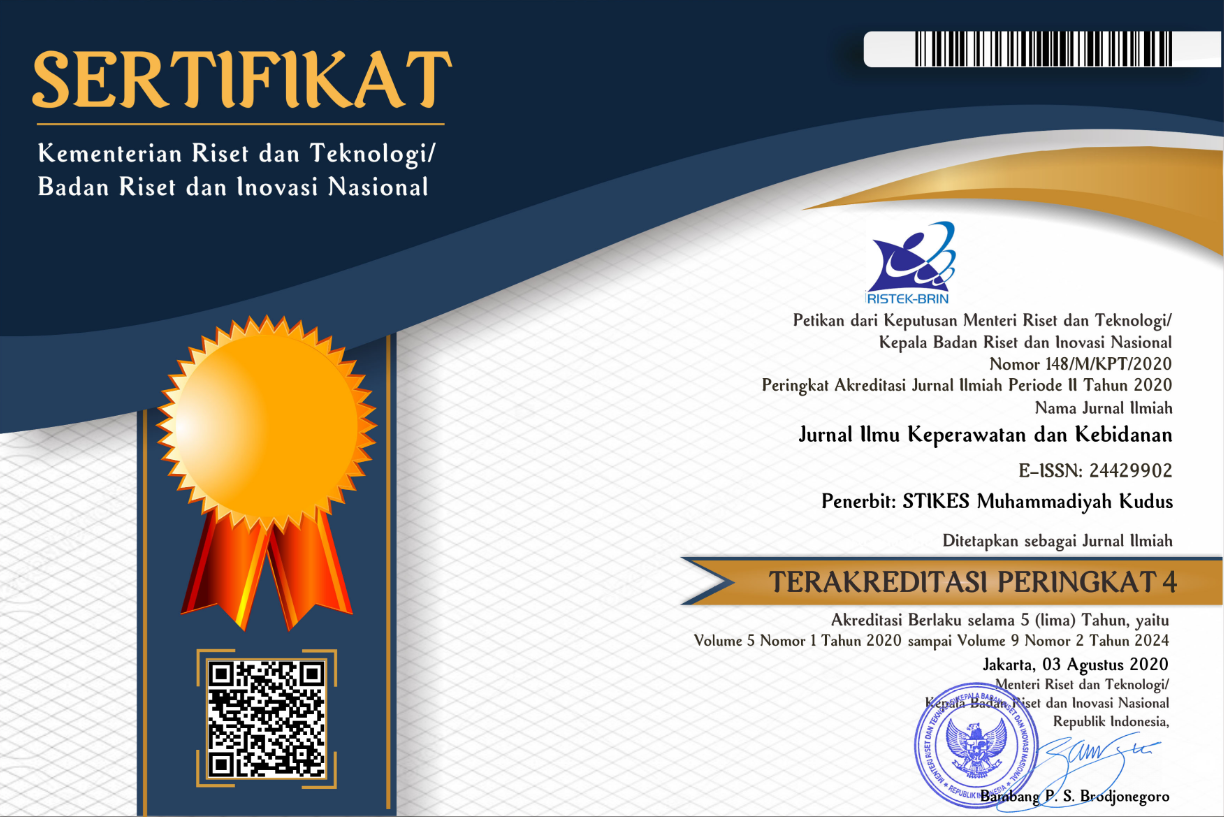RIWAYAT KEHAMILAN DAN PERSALINAN DENGAN KEJADIAN POSTPARTUM BLUES PADA IBU NIFAS DI KUDUS
Abstract
Giving birth is a woman's greatest gift and a very happy moment. Labor can also be a frightening state. Women who give birth often experience sadness and anxiety that affect their emotions. Postpartum blues is a mental disorder that occurs on day 1 after birth. Internal factors that influence postpartum blues are hormonal, psychological and personal fluctuations, previous depression, complications of pregnancy and childbirth. External factors are: caesarean section, unwanted pregnancies, low birth weight babies and mothers who have difficulty breastfeeding and caring for the baby. The prevalence of postpartum blues varies from 10 to 34 percent of all births in various countries. The incidence of postpartum blues in Japan ranges from 26 to 85%. About 20% of women who have recently given birth worldwide suffer from postpartum blues. Explanation of the relationship between pregnancy and childbirth with postpartum blues. Method: Correlation Analysis Study. using a cross-sectional approach. A sample of 64 postpartum mothers used a random sampling technique. Data were analyzed using the chi-square statistical test. Score: There is a relationship between previous pregnancies and postpartum blues with a P-value of 0.002 danlt; 0.05 and the probability is 5.682. There is a relationship between history of childbirth and postpartum blues, with a P-value of 0.023 danlt; 0.05 and the probability is 3,600. Diploma: There is a relationship between social support and the child's condition with the onset of postpartum blues.
Keywords
Full Text:
PDFReferences
Anjar Astuti, Yanik Muyassaroh, Murti Ani. 2020. “The Relationship Between Mother’s Pregnancy History and Baby’s Birth to the Incidence of Stunting in Infants.” 2.
Bloch, Miki, Nivi Rotenberg, Dan Koren, and Ehud Klein. 2005. “Risk Factors Associated with the Development of Postpartum Mood Disorders.” Journal of Affective Disorders 88(1): 9–18.
Cox, J. L., J. M. Holden, and R. Sagovsky. 1987. “Detection of Postnatal Depression: Development of the 10-Item Edinburgh Postnatal Depression Scale.” British Journal of Psychiatry 150(JUNE): 782–86.
Desfanita, Misrawati, Arneliwati. 2015. “FAKTOR-FAKTOR YANG MEMPENGARUHI POSTPARTUM BLUES.” Реєстрація, Зберігання І Обробка Даних 17(3): 56–64.
Dwitama, Muhammad Asep et al. 2021. “Mapping of High-Risk Detection of Women Pregnancy on Antenatal Care in Talise Health Center, Palu City, Indonesia.” Gaceta Sanitaria 35: S152–58. https://doi.org/10.1016/j.gaceta.2021.10.015
Ernawati, Ernawati. 2020. “Faktor Yang Berhubungan Dengan Kejadian Post Partum Blues Pada Ibu Nifas Di Ruang Nuri Rumah Sakit Bhayangkara Makassar.” Media Keperawatan: Politeknik Kesehatan Makassar 11(1): 25.
Hidaayah, Nur. 2018. “Hubungan Kesiapan Kehamilan Dengan Kejadian Post Partum Blues Pada Ibu Nifas Di Rsia Prima Husada Sidoarjo.” Journal of Health Sciences 8(2): 200–205.
Howard, Louise M et al. 2014. “Perinatal Mental Health 1 Non-Psychotic Mental Disorders in the Perinatal Period.” The Lancet 384(9956): 1775–88. http://dx.doi.org/10.1016/S0140-6736(14)61276-9.
Machmudah, Setyowati, Hayuni Rahmah, Imami Nur Rachmawati. 2012. “Persalinan Komplikasi Dan Kemungkinan Terjadinya Postpartm Blues Program Magister Ilmu Keperawatan Kekhususan Keperawatan Maternitas Fakultas Ilmu Keperawatan Universitas Indonesia , Kampus UI Depok , Jakarta 10430 , Indonesia Email :
DOI: https://doi.org/10.26751/jikk.v14i2.2020
Refbacks
- There are currently no refbacks.
Universitas Muhammadiyah Kudus - LPPM Universitas Muhammadiyah Kudus
Jl. Ganesha 1 Purwosari Kudus 59316
Tel/ Fax +62-291-437218 Email : lppm@umkudus.ac.id
Jurnal Ilmu Keperawatan dan Kebidanan Indexed by:

This work is licensed under a Creative Commons Attribution-ShareAlike 4.0 International License.













